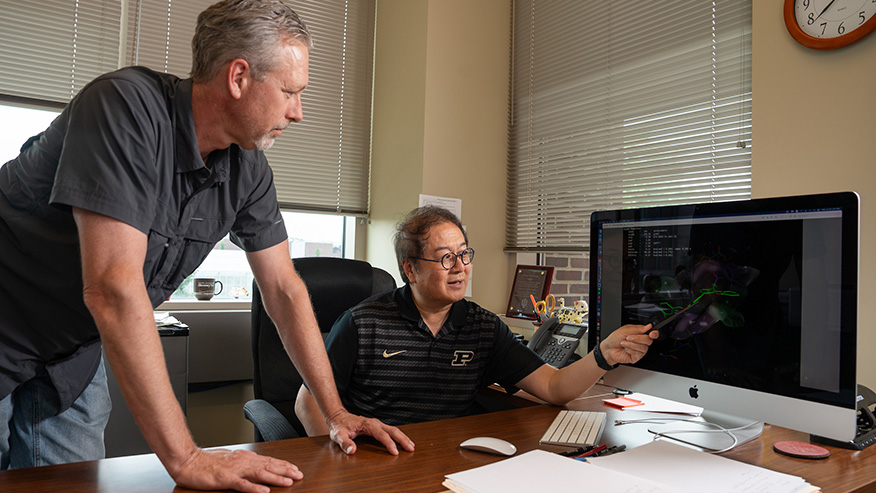
Purdue’s Mark Hall (left), professor of biochemistry, and Zhong-Yin Zhang, Distinguished Professor of Medicinal Chemistry, view the molecular structure of the Cdc14 enzyme with one of the inhibitors made in Zhang’s lab modeled in the active site. (Purdue University Photo/Joshua Clark)
August 14, 2025
In the wake of the COVID-19 pandemic, viral and bacterial infections tend to draw headlines. However, fungal pathogens are a rising problem that the colleges of Agriculture and Pharmacy at Purdue University have formed a collaboration to solve.
“Fungal infections kill almost 4 million people a year around the world. More people now die from fungal infections than from malaria and tuberculosis combined,” said Mark Hall, professor and associate department head of biochemistry. Hall and Zhong-Yin Zhang, Distinguished Professor, the Robert C. and Charlotte P. Anderson Chair in Pharmacology and director of the Purdue Institute for Drug Discovery, now jointly supervise a position held by a postdoctoral scientist who will help develop novel, patent-pending antifungal compounds. Their new hire, Jinhong Chen, forms the lynchpin of their collaboration focused on the Cdc14 enzyme.
“We’re fortunate to recruit Jinhong Chen, an outstanding synthetic chemist, to apply his skills to a therapeutic area,” Zhang said. Chen received his PhD in organic chemistry from Spain’s Institute of Chemical Research of Catalonia last December. His work is funded from a new Agricultural Research and Graduate Education program at Purdue called “Accelerating Giant Leaps: Agriculture’s Intersection with Computing, Analytics and One Health. After completing his postdoctoral training, Chen plans to carry out independent scientific research in medicinal chemistry to advance the development of novel drug candidates.
Through the One Health strategic initiative, Purdue’s researchers tackle complex challenges with real-world impact at the intersection of human, animal and plant health.
Fungal infections mostly affect immunocompromised people who are already sick or who have other chronic health conditions. But the immunocompromised population is growing as more people develop diabetes and other chronic health conditions and take immunosuppressing drugs to treat autoimmune diseases.
People undergoing chemotherapy are also prone to fungal infections because chemotherapy suppresses the immune system. This raises the possibility that a Cdc14 inhibitor could benefit cancer patients, Zhang said.
Hall noted that many COVID patients died from secondary infections, some of them caused by fungi like aspergillus, which infects the lungs. Fungal pathogens, meanwhile, are developing increasing resistance to the few antifungal drugs now in use.
Scientists attribute some of this resistance to the application of antifungal agents in agriculture. “There’s some reasonably good evidence for that. The pathogens are there,” Hall said.
The new project builds on findings that Hall and his Purdue colleagues have published in three journals in recent years. The first article, published in Scientific Reports, describes why the properties of Cdc14 enzymes would make them potential targets for developing new antifungal crop treatments.
The second, published in Frontiers in Microbiology, showed in laboratory experiments that Cdc14 is critically important for infections by Candida albicans, a common fungal pathogen in humans. And a study led by Zhang, published in the Journal of Medicinal Chemistry, identified a compound that acts specifically on the Cdc14 enzyme, which offers a way to assess its potential for drug development. So far, this research is based on animal models.
“We’ve done studies with one of the compounds identified in the Zhang lab that specifically inhibits the fungal Cdc14, which is the main fungal pathogen that we study,” Hall said. “It’s not a perfect drug, so we need to make it better.”
Zhang’s lab specializes in devising inhibitors for protein tyrosine phosphatases, the enzyme family that includes Cdc14. While screening compound collections synthesized by group members for effectiveness against various enzymes in the family, Zhang’s team found one that acted specifically on Cdc14, leading to the collaboration with Hall. Zhang and Hall disclosed their innovation to the Purdue Innovates Office of Technology Commercialization, which has applied for a patent to protect the intellectual property. The application was filed on their existing Cdc14 inhibitors for uses in cancer treatment, fungal infections and crop production.
The Cdc14 enzyme in humans may play a role in cancer. Since fungi also carry this enzyme, a compound that inhibits Cdc14 could apply to fungal infections as well as cancer in humans, Zhang noted. The enzyme exhibits both similar and unique features in the various organisms that carry it. Each target may thus require a different chemistry to drive the inhibitor. If cancer is the target, scientists must focus on the human enzyme.
Zhang has been pursuing drug discovery that targets protein tyrosine phosphatases for treating a wide range of conditions, including obesity, diabetes, tuberculosis, Yersinia pestis (bubonic plague), autoimmune diseases, Alzheimer’s and cancer. His work includes developing the molecule that inhibits the Cdc14 human enzyme. Zhang’s collaboration with Hall, however, marks his first foray into antifungal research.
“The goal is to improve upon the molecule that we have already tested. I would call it a first-generation Cdc14 inhibitor,” Zhang said. “That’s why we need a chemist with strong synthetic skills.”
Chen’s task is to improve the effectiveness of the first-generation inhibitor many times over. He brings to the project nearly seven years of experience in synthetic chemistry, specifically in the total synthesis of biologically active natural products and the modification of widely existing carbon-hydrogen bonds. This involves building complex organic molecules of medicinal value from more basic chemical compounds.
Chen has already identified some promising candidate compounds. Now he will attempt to optimize their effectiveness via two major molecular design strategies. Fragment-based design builds up druglike compounds from chemical fragments. Structure-based design develops medically active compounds by systematically modifying their molecular structures based on structural insights.
“Then we synthesize these targeted compounds, purify them, characterize them and test them,” Chen said. The process will include testing the compounds for selectivity against other phosphatases.
“There are hundreds of protein phosphatases in the human genome, plants and other organisms,” Zhang said. “We want to make sure they’re specific for the target.”
Writer: Steve Koppes, College of Agriculture
Original Story: https://ag.purdue.edu/news/2025/08/joint-agriculture-pharmacy-project-seeks-to-develop-novel-antifungal-treatment.html



